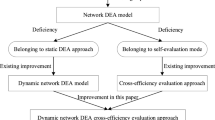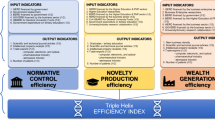Abstract
This paper proposes a lexicographic decomposition strategy for the two-stage network DEA model. Instead of assigning a priority over the two component stages, our proposed approach employs a lexicographic algorithm in such a way that the system efficiencies of the DMUs are lexicographically computed for each of their possible sequences while maintaining the efficiencies of those units already investigated unchanged. In particular, the system efficiency and the two component efficiencies can be uniquely determined under our proposed decomposition approach. Besides, prior to implement the proposed lexicographic evaluation procedure, we also highlight a potential infeasibility problem arising from the normalization constraint, and develop a modified iterative approach that facilitates us to guarantee a feasible search procedure. Finally, we use a numerical example to illustrate the effectiveness of the proposed approach, and conduct an empirical study to analyze China’s regional high-tech innovation systems for the period of 12th Five-Year Plan (2011–2015).







Similar content being viewed by others
Notes
In order to guarantee the uniqueness of the multipliers used for calculating the component efficiencies, Kao and Liu (2019) maximized the aggregate efficiency of all DMUs for the arbitrary most important division while maintaining the aggregate system efficiency of the other DMUs unchanged. However, such a practice cannot guarantee unique efficiency decomposition.
Herein, it is worth noting that there are generally two strategies to decompose the system efficiency under the two-stage production structure, namely the multiplicative decomposition strategy (MDS) proposed by Kao and Hwang (2008) and the additive decomposition strategy (ADS) proposed by Chen et al. (2009). For the MDS, it interprets the system efficiency as the product of two sub-stage efficiencies, i.e., \(\theta_{o} = \theta_{o}^{1} \times \theta_{o}^{2}\). However, this approach suffer from several shortcomings, for example, it fails to handle the situations in which a VRS assumption is required, and it becomes nonlinear when additional constraints are included. To resolve these problems, Chen et al. (2009) aggregate the components of a two-stage process by interpreting the system efficiency as the weighted average of component efficiencies. In doing so, as we will introduce below, the corresponding model can be easily transformed into a linear one.
In doing so, we can always guarantee a bounded solution to model (12). Otherwise, model (12) may be unbounded as the objective of this model is to maximize the value of \(\sum\nolimits_{i = 1}^{m} {\varpi_{i} x_{{i\sigma \left( {\ell + 1} \right)}} } + \sum\nolimits_{d = 1}^{D} {\zeta_{d} z_{{d\sigma \left( {\ell + 1} \right)}} }\), which may be infinity as one only restricts that the overall efficiency of concerned DMUs should be maintained.
We do not include Qinghai, Tibet, Hong Kong, Macao, and Taiwan due to data limits.
Although not all inventions can be regarded as a patent, and the patents are actually differing greatly in quality (Chen, et al., 2018), the PA is indeed a reasonable and reliable indicator of unobserved innovation output.
Specifically, to guarantee the feasibility of our concerned models, according to Proposition 1, we set \(\varepsilon = 10^{ - 8}\). In addition, following Lee et al. (2019), our study focuses primarily on the VRS condition.
References
Acs, Z. J., Anselin, L., & Varga, A. (2002). Patents and innovation counts as measures of regional production of new knowledge. Research Policy, 31, 1069–1085.
Al-Siyabi, M., Amin, G. R., Bose, S., & Al-Masroori, H. (2019). Peer-judgment risk minimization using DEA cross-evaluation with an application in fishery. Annals of Operations Research, 274(1–2), 39–55.
Amin, G. R., & Toloo, M. (2004). A polynomial-time algorithm for finding epsilon in DEA models. Computers & Operations Research, 31(5), 803–805.
An, Q., Meng, F., Xiong, B., Wang, Z., & Chen, X. (2020). Assessing the relative efficiency of Chinese high-tech industries: A dynamic network data envelopment analysis approach. Annals of Operations Research, 290, 707–729.
Banker, R. D., Charnes, A., & Cooper, W. W. (1984). Some models for estimating technical and scale inefficiencies in data envelopment analysis. Management Science, 30, 1078–1092.
Carayannis, E. G., Grigoroudis, E., & Goletsis, Y. (2016). A multilevel and multistage efficiency evaluation of innovation systems: A multiobjective DEA approach. Expert Systems with Applications, 62, 63–80.
Charnes, A., & Cooper, W. W. (1962). Programming with linear fractional functionals. Naval Research Logistics (NRL), 9, 181–186.
Charnes, A., Cooper, W. W., & Rhodes, E. (1978). Measuring the efficiency of decision making units. European Journal of Operational Research, 2, 429–444.
Chen, C.-M., & van Dalen, J. (2010). Measuring dynamic efficiency: Theories and an integrated methodology. European Journal of Operational Research, 203, 749–760.
Chen, H. (2018). Average lexicographic efficiency for data envelopment analysis. Omega, 74, 82–91.
Chen, K., & Guan, J. (2012). Measuring the efficiency of China’s regional innovation systems: Application of Network Data Envelopment Analysis (DEA). Regional Studies, 46, 355–377.
Chen, K., & Kou, M. (2014). Staged efficiency and its determinants of regional innovation systems: A two-step analytical procedure. The Annals of Regional Science, 52(2), 627–657.
Chen, X., Liu, Z., & Zhu, Q. (2018). Performance evaluation of China’s high-tech innovation process: Analysis based on the innovation value chain. Technovation, 74, 42–53.
Chen, Y., Cook, W. D., Li, N., & Zhu, J. (2009). Additive efficiency decomposition in two-stage DEA. European Journal of Operational Research, 196, 1170–1176.
Chu, J., Wu, J., Chu, C., & Zhang, T. (2020). DEA-based fixed cost allocation in two-stage systems: Leader-follower and satisfaction degree bargaining game approaches. Omega, 94, 102054.
Cook, W. D., & Seiford, L. M. (2009). Data envelopment analysis (DEA)–Thirty years on. European Journal of Operational Research, 192, 1–17.
Despotis, D. K., Koronakos, G., & Sotiros, D. (2016a). Composition versus decomposition in two-stage network DEA: A reverse approach. Journal of Productivity Analysis, 45, 71–87.
Despotis, D. K., Koronakos, G., & Sotiros, D. (2016b). The “weak-link” approach to network DEA for two-stage processes. European Journal of Operational Research, 254(2), 481–492.
Emrouznejad, A., & Yang, G.-L. (2018). A survey and analysis of the first 40 years of scholarly literature in DEA: 1978–2016. Socio-Economic Planning Sciences, 61, 4–8.
Färe, R., & Grosskopf, S. (2000). Network DEA Network DEA. Socio-Economic Planning Sciences, 34, 35–49.
Galagedera, D. U., Roshdi, I., Fukuyama, H., & Zhu, J. (2018). A new network DEA model for mutual fund performance appraisal: An application to US equity mutual funds. Omega, 77, 168–179.
Gerami, J., Mavi, R. K., Saen, R. F., & Mavi, N. K. (2020). A novel network DEA-R model for evaluating hospital services supply chain performance. Annals of Operations Research. https://doi.org/10.1007/s10479-020-03755-w.
Golany, B., & Roll, Y. (1989). An application procedure for DEA. Omega, 17, 237–250.
Guan, J., & Chen, K. (2010a). Measuring the innovation production process: A cross-region empirical study of China’s high-tech innovations. Technovation, 30, 348–358.
Guan, J., & Chen, K. (2010b). Modeling macro-R&D production frontier performance: An application to Chinese province-level R&D. Scientometrics, 82, 165–173.
Guan, J., & Chen, K. (2012). Modeling the relative efficiency of national innovation systems. Research Policy, 41, 102–115.
Guo, C., Shureshjani, R. A., Foroughi, A. A., & Zhu, J. (2017). Decomposition weights and system efficiency in two-stage additive network DEA. European Journal of Operational Research, 257, 896–906.
Kao, C. (2014). Network data envelopment analysis: A review. European Journal of Operational Research, 239, 1–16.
Kao, C. (2017). Efficiency measurement and frontier projection identification for general two-stage systems in data envelopment analysis. European Journal of Operational Research, 261, 679–689.
Kao, C., & Hwang, S.-N. (2008). Efficiency decomposition in two-stage data envelopment analysis: An application to non-life insurance companies in Taiwan. European Journal of Operational Research, 185, 418–429.
Kao, C., & Liu, S.-T. (2019). Cross efficiency measurement and decomposition in two basic network systems. Omega, 83, 70–79.
Kogan, L., Papanikolaou, D., Seru, A., & Stoffman, N. (2017). Technological innovation, resource allocation, and growth. The Quarterly Journal of Economics, 132, 665–712.
Lee, J., Kim, C., & Choi, G. (2019). Exploring data envelopment analysis for measuring collaborated innovation efficiency of small and medium-sized enterprises in Korea. European Journal of Operational Research, 278(2), 533–545.
Liang, L., Cook, W. D., & Zhu, J. (2008). DEA models for two-stage processes: Game approach and efficiency decomposition. Naval Research Logistics (NRL), 55, 643–653.
Liu, J. S., & Lu, W.-M. (2010). DEA and ranking with the network-based approach: A case of R&D performance. Omega, 38, 453–464.
Liu, J. S., Lu, W. M., & Ho, M. H. C. (2015). National characteristics: Innovation systems from the process efficiency perspective. R&D Management, 45(4), 317–338.
Lu, W.-M., Kweh, Q. L., Nourani, M., & Huang, F.-W. (2016). Evaluating the efficiency of dual-use technology development programs from the R&D and socio-economic perspectives. Omega, 62, 82–92.
Mehrabian, S., Jahanshahloo, G. R., Alirezaee, M., & Amin, G. R. (2000). An assurance interval for the non-Archimedean epsilon in DEA models. Operations Research, 48(2), 344–347.
Oxman, J. A. (1992). The global service quality measurement program at American Express Bank. National Productivity Review, 11, 381–392.
Post, T., Cherchye, L., & Kuosmanen, T. (2002). Nonparametric efficiency estimation in stochastic environments. Operations Research, 50, 645–655.
Wang, K., Huang, W., Wu, J., & Liu, Y.-N. (2014). Efficiency measures of the Chinese commercial banking system using an additive two-stage DEA. Omega, 44, 5–20.
Wang, Q., Hang, Y., Sun, L., & Zhao, Z. (2016). Two-stage innovation efficiency of new energy enterprises in China: A non-radial DEA approach. Technological Forecasting and Social Change, 112, 254–261.
Xiong, X., Yang, G., & Guan, Z. (2018). Assessing R&D efficiency using a two-stage dynamic DEA model: A case study of research institutes in the Chinese Academy of Sciences. Journal of Informetrics, 12(3), 784–805.
Xu, S., Fang, L., & Govindan, K. (2022). Energy performance contracting in a supply chain with financially asymmetric manufacturers under carbon tax regulation for climate change mitigation. Omega, 106, 102535.
Zhang, B., Luo, Y., & Chiu, Y.-H. (2019). Efficiency evaluation of China’s high-tech industry with a multi-activity network data envelopment analysis approach. Socio-Economic Planning Sciences, 66, 2–9.
Zhu, Q., Wu, J., & Song, M. (2018). Efficiency evaluation based on data envelopment analysis in the big data context. Computers & Operations Research, 98, 291–300.
Zuo, K., & Guan, J. (2017). Measuring the R&D efficiency of regions by a parallel DEA game model. Scientometrics, 112, 175–194.
Acknowledgements
The authors would especially like to thank the editors, and three anonymous reviewers whose comments led to significant improvements in the paper. This work is supported by the National Natural Science Foundation of China under grant (No. 71671095), the Tianjin Philosophy and Social Science Planning Key Project (TJGL21-009), and the Fundamental Research Funds for the Central Universities (No. 2232021E-10).
Author information
Authors and Affiliations
Corresponding author
Ethics declarations
Conflict of interest
The authors declare that they have no conflict of interest.
Additional information
Publisher's Note
Springer Nature remains neutral with regard to jurisdictional claims in published maps and institutional affiliations.
Appendix
Appendix
See Tables 13, 14, 15, 16, 17.
Rights and permissions
About this article
Cite this article
Yang, J., Fang, L. Average lexicographic efficiency decomposition in two-stage data envelopment analysis: an application to China’s regional high-tech innovation systems. Ann Oper Res 312, 1051–1093 (2022). https://doi.org/10.1007/s10479-021-04427-z
Accepted:
Published:
Issue Date:
DOI: https://doi.org/10.1007/s10479-021-04427-z




